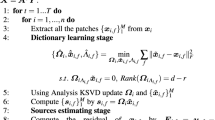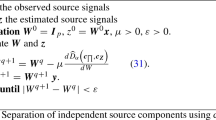Abstract
Underdetermined blind source separation based on compressed sensing (CS) has already been proven to be an effective mechanism from an experimental viewpoint. In this study, we develop a theoretical result and show that, under a certain sparsity constraint for the restricted isometry property, the accuracy of CS when retrieving sources is guaranteed. This theoretical result can be regarded as a generalization of the blocked polynomial deterministic matrix theory and has been confirmed using numerical examples.








Similar content being viewed by others
References
T. Blumensath, M.E. Davies, Compressed sensing and source separation, in Proceedings of the International Conference on Independent Component Analysis and Blind Source Separation, pp. 341–348 (2007)
E. Candes, J. Romberg, T. Tao, Robust uncertainty principles: exact signal reconstruction from highly in complete frequency information. IEEE Trans. Inf. Theory 52(2), 489–509 (2006)
R.A. Devore, Deterministic constructions of compressed sensing matrices. J. Complex. 23(4–6), 918–925 (2007)
T.B. Dong, Y.K. Lei, J.S. Yang, An algorithm for underdetermined mixing matrix estimation. Neurocomputing 104, 26–34 (2013)
D.L. Donoho, Y. Tsaig, I. Drori, J.L. Starck, Sparse solution of underdetermined systems of linear equations by stagewise orthogonal matching pursuit. IEEE Trans. Inf. Theory 58(2), 1094–1121 (2012)
A. Flinth, A geometrical stability condition for compressed sensing. Linear Algebra Appl. 504, 406–432 (2016)
Z.Y. He, S.L. Xie, L. Zhang, A. Cichocki, A note on Lewicki–Sejnowski gradient for learning overcomplete representation. Neural Comput. 20(3), 636–643 (2008)
R. Holger, S. Karin, V. Pierre, Compressed sensing and redundant dictionaries. IEEE Trans. Inf. Theory 54(5), 2210–2219 (2008)
X.B. Li, R.Z. Zhao, S.H. Hu, Blocked polynomial deterministic matrix for compressed sensing, in Proceedings of the International Conference on Wireless Communications, Networking and Mobile Computing, pp. 1–4 (2010)
F.M. Naini, H. Mohimani, M. Zadeh, C. Jutten, Estimating the mixing matrix in space component analysis based on partial k-dimensional subspace clustering. Neurocomputing 71, 2330–2343 (2008)
D. Needell, J.A. Tropp, CoSaMP: iterative signal recovery from incomplete and inaccurate samples. Appl. Comput. Harmon. Anal. 26(3), 301–321 (2008)
D. Needell, R. Vershynin, Signal recovery from inaccurate and incomplete measurements via regularized orthogonal matching pursuit. IEEE J. Sel. Top. Signal Process. 4(2), 310–316 (2010)
R.C. Shi, F. Wei, Matrix Analysis, 2nd edn. (Beijing Institute of Technology Press, Beijing, 2008)
A.G. Shwetha, V.S. Saroja, Compressed sensing reconstruction of an audio signal using OMP. Int. J. Adv. Comput. Res. 5(18), 75–79 (2015)
Y.C. Sun, J. Xin, Underdetermined sparse blind source separation of nonnegative and partially overlapped data. SIAM J. Sci. Comput. 33(4), 2063–2094 (2011)
J. Wang, S. Kwon, B. Shim, Generalized orthogonal matching pursuit. IEEE Trans. Signal Process. 60(12), 6202–6216 (2012)
J. Wang, S. Kwon, P. Li, B. Shim, Recovery of sparse signals via generalized orthogonal matching pursuit: a new analysis. IEEE Trans. Signal Process. 64(4), 1076–1089 (2016)
K. Wei, Fast iterative hard thresholding for compressed sensing. IEEE Signal Process. Lett. 22(5), 593–597 (2015)
Y.J. Xie, Y.F. Ke, C.F. Ma, The modified accelerated bergman method for regularized basis pursuit problem. J. Inequal. Appl. 2014(1), 1–17 (2014)
T. Xu, W.W. Wang, A compressed sensing approach for underdetermined blind audio source separation with sparse representation, in Proceedings of the IEEE International Workshop on Statistical Signal Processing, pp. 493–496 (2009)
J.D. Xu, X.C. Yu, D. Hu, L.B. Zhang, A fast mixing matrix estimation method in the wavelet domain. Signal Process. 95, 58–66 (2014)
T. Xu, W.W. Wang, A block-based compressed sensing method for underdetermined blind speech separation incorporating binary mask, in Proceedings of the IEEE International Conference on Acoustics, Speech and Signal Processing (ICASSP2010), pp. 2022–2025 (2010)
E. Yonina, K. Gitta, Compressed Sensing Theory and Applications (Cambridge University Press, Cambridge, 2012)
Acknowledgements
This work was partially supported by the Natural Science Foundation of China under Grant No. 61601417. The authors would like to thank the anonymous reviewers for their thorough reading of the paper and patient feedback.
Author information
Authors and Affiliations
Corresponding author
Appendix: Proof of Theorem 2
Appendix: Proof of Theorem 2
From Eq. (5), the length and sparsity of signal \(\varvec{\uptheta }\) are NL and K, respectively. \(\Gamma \in \{1,\;2,\;\ldots ,\;NL\}\) and \({\#}(\Gamma )=K\). Without loss of generality, we assume that the source signals \(\mathbf{s}\) are sparse in the time domain, then the sparsity of \(\varvec{\uptheta }_i \) is \(K_i \). Then, the Gramian matrix can be written as follows:
where \(\mathbf{D}_{\Gamma _i } =\varvec{\Pi }_{\Gamma _i }^\mathrm {T} \varvec{\Pi }_{\Gamma _i } \); That is,
From Eq. (12), we have
-
(i)
when \(k,\;h\in \Gamma _i \)
-
(a)
if \(k=h\), then \(\mathbf{D}_\Gamma (k,\;k)=1\);
-
(b)
if \(k\ne h,\mathbf{D}_\Gamma (k,\;h)=\sum \limits _{j=1}^{ML} {\varvec{\Pi }_\Gamma (j,\;k)} \varvec{\Pi }_\Gamma (j,\;h)=\langle \mathbf{a}_{{k}'} ,\mathbf{a}_{{h}'} \rangle \).
-
(a)
-
(ii)
when \(k\in \Gamma _i ,\;h\in \Gamma _j ,\;i\ne j,\;\mathbf{D}_\Gamma (k,\;h)=0\).
Because any off-diagonal entry of \(\mathbf{D}_\Gamma \) is less than \(\mathop {\max }\limits _{k\ne h} \{\mathbf{D}_\Gamma (k,\;h)\}\), the off-diagonal entries in any row or column of \(\mathbf{D}_\Gamma \) have sum
then
Let \(\delta =\mathop {\max }\limits _{i=1, 2, \ldots , L} \delta _i <1\), then
Hence, we write
where \(\mathbf{I}\) is a unit matrix and
As \(\mathbf{B}_\Gamma \) is a symmetric matrix, by interpolation of operators, we obtain that
where \(\rho (\mathbf{B}_\Gamma )\) denote the spectral norm of \(\mathbf{B}_\Gamma \). Since \(\parallel \mathbf{A}+\mathbf{B}\parallel _2 \le \parallel \mathbf{A}\parallel _2 +\parallel \mathbf{B}\parallel _2 \) for any matrices \(\mathbf{A}\) and \(\mathbf{B}\) [13], it follows that
Therefore, \(\mathbf{D}_\Gamma \) has eigenvalues in \([1-\delta ,\;1+\delta ]\). Therefore, we have proved that matrix \(\varvec{\Pi }\) satisfies the RIP with \(\delta =\mathop {\max }\limits _{i=1, 2, \ldots , L} \delta _i \).
Rights and permissions
About this article
Cite this article
Zhang, Y., Zhang, S. & Qi, R. Compressed Sensing Construction for Underdetermined Source Separation. Circuits Syst Signal Process 36, 4741–4755 (2017). https://doi.org/10.1007/s00034-017-0520-y
Received:
Revised:
Accepted:
Published:
Issue Date:
DOI: https://doi.org/10.1007/s00034-017-0520-y




